The Onion magazine suggests we should consider the gap between rich and poor the Eighth Wonder of the World — “a tremendous, millennia-old expanse that fills us with both wonder and humility … the most colossal and enduring of mankind’s creations.”
Another aspect of the rich-poor gap that has always filled me with wonder is how the rich manage to keep it off the political agenda.
The dramatic increase in the incomes of the wealthy — even as the incomes of most working people have been stagnant or declining — is surely one of the most significant changes in our society in recent years. Yet it is never treated as a pressing issue that must be addressed — or as much of an issue at all.
This is certainly the case in the United States, where the redirection of money to the top has been particularly pronounced. Out of three million political ads aired during the recent U.S. congressional campaign, not one dealt with America’s growing wealth gap, either to defend it or confront it, according to Sam Pizzigati, editor of an online newsletter on inequality run by the Washington-based Institute for Policy Studies.
The issue of rising inequality was essentially invisible — off-limits for political debate.
The issue is largely invisible here in Canada, too. While there is much talk about the “squeeze on the middle class” and the occasional mention of poverty, there is no focus on the fact that income and wealth have been significantly redistributed from the 99% to the 1% over the past three decades — and notably since the 2008 recession.
Those on the right argue that focusing on the growing incomes of the rich amounts to a toxic and divisive “politics of envy” that is best avoided.
Right-wingers never shy away from using the “politics of envy” when it suits them, of course — for example, by drumming up resentment against civil servants who have pensions, thereby building public support for cutting those pensions (and the civil servants themselves).
This ensures that the frustration of workers without pensions will be directed at those with pensions, rather than at the corporations and governments who refuse to provide all workers with decent pensions, as is done in many European countries.
This lack of focus on income concentration at the top is partly due to the common perception that it’s primarily an American phenomenon. It’s true that the U.S. has the most extreme inequality, but a recent OECD report noted that Canada has the second-largest share of income growth going to top earners.
However, even that OECD report understates the drift of wealth to the top in Canada — according to dramatic data from a recent academic study which received relatively little attention.
The study — by university professors Michael Wolfson, Michael Veall and Neil Brooks — is based on previously unavailable income tax return data. It shows that billions of dollars in income received by the very richest Canadians have not been included in calculations of their income. That’s because the wealthy funneled this money through private corporations in order to legally reduce their taxes — a practice that is more widely used in Canada than the U.S.
Once this income — amounting to an astonishing $48 billion in 2010 — is added to their reported personal incomes, Canada’s rich are considerably richer than we’ve been led to believe.
For example, according to commonly used data, the average income for Canadians in the top one per cent is $359,900. However, this doesn’t include money channeled through their private corporations. Once we include this additional income, the actual average income of these high-rollers rises to a much heftier $500,200.
The higher we go up the income ladder into the clouds, the more prevalent the use of private corporations — and the richer the rich turn out to be as a result.
Take the richest 0.01 per cent of Canadians: 85 per cent of them funnel income through private corporations. Once this income is added, the average income of these extremely rich individuals almost doubles — from $4.69 million to an eye-popping $8 million a year.
The study also shows that the share of Canada’s national income going to the top one per cent — commonly believed to be ten per cent — is actually 13.3 per cent, once private corporation income is included. This share has been rising, from 12 per cent in 2009 to 13.3 per cent in 2011 (the latest year available).
Apart from the obvious issue of fairness, this diversion of money to the top raises other issues that should be central to meaningful public debate.
For instance, there is growing evidence that a high level of inequality hurts economic growth — presumably something voters might want to know. A staff report released earlier this year by economists at the International Monetary Fund noted: “Recent empirical work finds that high levels of inequality are harmful for the pace and sustainability of growth.”
Even more worrisome is the impact on democracy, as Canada’s 70 billionaires and hundreds of multi-millionaires become ever more dominant in the political sphere, with an effective veto over a range of economic policies.
It’s hard to imagine a development more crucial to the future of Canadian democracy. Just don’t expect to hear much about it during the coming election campaign.
Winner of a National Newspaper Award, Linda McQuaig has been a reporter for the Globe and Mail, a columnist for the National Post and the Toronto Star and author of seven bestsellers, including Shooting the Hippo: Death by Deficit and other Canadian Myths and It’s the Crude, Dude: War, Big Oil and the Fight for the Planet. Her most recent book (co-written with Neil Brooks) is The Trouble with Billionaires: How the Super-Rich Hijacked the World, and How We Can Take It Back.
This article is reprinted with permission from iPolitics ![]()
Photo: v i p e z/flickr




